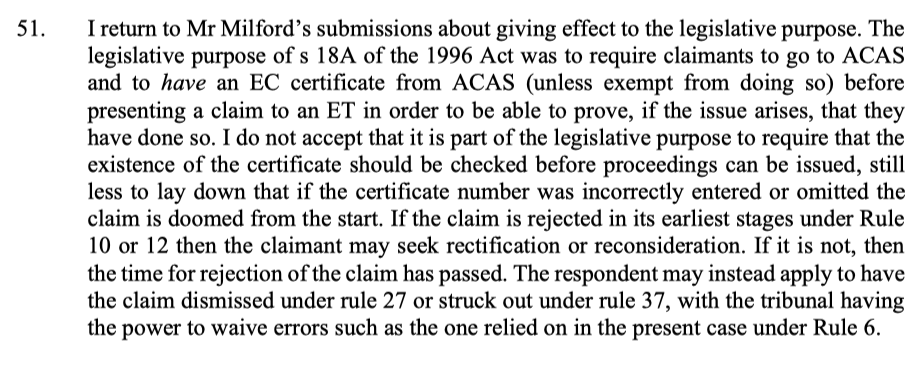🧵Most appellate judgments keep you waiting to the end to work out who's won or lost. Sainsbury's v Clark is a welcome exception. The CA made clear as early as para 3 its disdain for the suggestion 100s of claimants should be struck out as their ACAS EC numbers weren't on the ET1 

2/ The appeal forms the next preliminary chapter in one of the supermarket equal pay claims, which have now been ongoing for 8 years without reaching trial. Bean LJ made clear both in the hearing & in judgment his disdain of this lengthy litigation process. 

3/ The CA noted that ET claim forms (both ET1 and the multiple claimant ET1A) only provide 1 box for an ACAS EC number for each respondent, & provides no extra boxes for details for 2nd, 3rd etc claimant details. The claimants here were set out in a schedule but not with EC nos. 

4/ The question in this case was whether the ET should reject (& strike out if not rejected) claims by claimants whose EC number wasn't included on the ET1 issued for a multiple claimant claim.
5/ The CA upheld the EAT in finding that r.10 of the ET rules merely required the EC number for a certificate on which 1 of the prospective claimants appeared, not all of them, & hence there was no basis under r.10 for the claims in this case to be rejected. 

6/ Moreover, ET rr.10-12 are prelim filters, with r.10 being an admin exercise not involving an EJ. If there's no rejection, the respondent can't later argue that it should've been rejected (even if right about that). It can only seek dismissal under r.27 or apply for strike out. 

7/ That application would then render applicable the ET's power to waive non-compliance with a rule under ET r.6. That applies to breaches falling within rr.10-12 as much as the later parts of the ET rules. 

8/ The legislative purpose of s.18A of the ETA 1996 was to require claimant to go to ACAS & to have an EC certificate (unless exempt) before presenting a claim. It wasn't part of the purpose to doom claims before the start if the number was wrongly entered or omitted from the ET1 

9/ Hence the rules provide for the seeking of rectification or reconsideration where a claim is rejected at the prelim filter stage & provide for waiver of non-compliance under r.6 where not rejected but where the respondent applies for dismissal/strike out for lack of EC no.
10/ Hence the CA found against Sainsbury's on 2 bases: first, the requirements of the rules being limited to just 1 correct EC number, & 2ndly to the ways in which an error in an EC number can be rectified/waived to prevent a claim being doomed for omission.
• • •
Missing some Tweet in this thread? You can try to
force a refresh

 Read on Twitter
Read on Twitter









